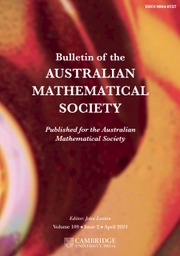No CrossRef data available.
Article contents
ON GALOIS GROUPS OF POWER COMPOSITIONAL NONIC POLYNOMIALS
Published online by Cambridge University Press: 10 February 2025
Abstract
Let  $g(x)=x^3+ax^2+bx+c$ and
$g(x)=x^3+ax^2+bx+c$ and  $f(x)=g(x^3)$ be irreducible polynomials with rational coefficients, and let
$f(x)=g(x^3)$ be irreducible polynomials with rational coefficients, and let  $ {\mathrm{Gal}}(f)$ be the Galois group of
$ {\mathrm{Gal}}(f)$ be the Galois group of  $f(x)$ over
$f(x)$ over  $\mathbb {Q}$. We show
$\mathbb {Q}$. We show  $ {\mathrm{Gal}}(f)$ is one of 11 possible transitive subgroups of
$ {\mathrm{Gal}}(f)$ is one of 11 possible transitive subgroups of  $S_9$, defined up to conjugacy; we use
$S_9$, defined up to conjugacy; we use  $ {\mathrm{Disc}}(f)$,
$ {\mathrm{Disc}}(f)$,  $ {\mathrm{Disc}}(g)$ and two additional low-degree resolvent polynomials to identify
$ {\mathrm{Disc}}(g)$ and two additional low-degree resolvent polynomials to identify  $ {\mathrm{Gal}}(f)$. We further show how our method can be used for determining one-parameter families for a given group. Also included is a related algorithm that, given a field
$ {\mathrm{Gal}}(f)$. We further show how our method can be used for determining one-parameter families for a given group. Also included is a related algorithm that, given a field  $L/\mathbb {Q}$, determines when L can be defined by an irreducible polynomial of the form
$L/\mathbb {Q}$, determines when L can be defined by an irreducible polynomial of the form  $g(x^3)$ and constructs such a polynomial when it exists.
$g(x^3)$ and constructs such a polynomial when it exists.
MSC classification
- Type
- Research Article
- Information
- Copyright
- © The Author(s), 2025. Published by Cambridge University Press on behalf of Australian Mathematical Publishing Association Inc.



